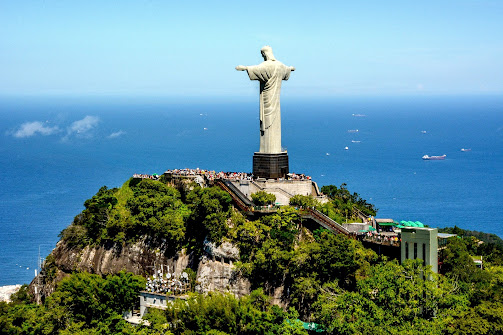Christ the Redeemer Brazil
Christ the Redeemer
Christ the Redeemer is a statue of Jesus Christ in Rio de Janeiro, Brazil; considered the second largest Art Deco statue in the world. The statue is 39.6 meters (130 ft) tall, including its 9.5 meter (31 feet) pedestal, and 30 meters (98 ft) wide. It weighs 635 tones (700 short tons), and is located at the peak of the 700-metre (2,300 ft) Corcovado mountain in the Tijuca Forest National Park overlooking the city. A symbol of Christianity, the statue has become an icon of Rio and Brazil. It is made of reinforced concrete and soapstone, and was constructed between 1922 and 1931.
The idea for erecting a large statue atop Corcovado was first suggested in the mid-1850s, when Catholic priest Pedro Maria Boss requested financing from Princess Isabel to build a large religious monument. Princess Isabel did not think much of the idea and it was dismissed in 1889, when Brazil became a republic with laws mandating the separation of church and state. The second proposal for a landmark statue on the mountain was made in 1921 by the Catholic Circle of Rio. The group organized an event called Semana do Monumento ("Monument Week") to attract donations and collect signatures to support the building of the statue. The donations came mostly from Brazilian Catholics. The designs considered for the "Statue of the Christ" included a representation of the Christian cross, a statue of Jesus with a globe in his hands, and a pedestal symbolizing the world. The statue of Christ the Redeemer with open arms was chosen. It is a symbol of peace as well. There are small spikes on top of the statue in order to prevent birds from resting on it.
In October 2006, on the statue's 75th anniversary, Archbishop of Rio Cardinal Eusebio Oscar Scheid consecrated a chapel (named after the patron saint of Brazil—Nossa Senhora Aparecida, or "Our Lady of the Apparition,") under the statue. This allows Catholics to hold baptisms and weddings there.
Christ the Redeemer
The idea for erecting a large statue atop Corcovado was first suggested in the mid-1850s, when Catholic priest Pedro Maria Boss requested financing from Princess Isabel to build a large religious monument. Princess Isabel did not think much of the idea and it was dismissed in 1889, when Brazil became a republic with laws mandating the separation of church and state. The second proposal for a landmark statue on the mountain was made in 1921 by the Catholic Circle of Rio. The group organized an event called Semana do Monumento ("Monument Week") to attract donations and collect signatures to support the building of the statue. The donations came mostly from Brazilian Catholics. The designs considered for the "Statue of the Christ" included a representation of the Christian cross, a statue of Jesus with a globe in his hands, and a pedestal symbolizing the world. The statue of Christ the Redeemer with open arms was chosen. It is a symbol of peace as well. There are small spikes on top of the statue in order to prevent birds from resting on it.
In October 2006, on the statue's 75th anniversary, Archbishop of Rio Cardinal Eusebio Oscar Scheid consecrated a chapel (named after the patron saint of Brazil—Nossa Senhora Aparecida, or "Our Lady of the Apparition,") under the statue. This allows Catholics to hold baptisms and weddings there.
Christ the Redeemer

Christ the Redeemer
Traveling to Christ The Redeemer
Devotees flock to the site to get a sense of the peace and hope it provides, and ordinary tourists approach it to appease their curiosity regarding the spirituality that this statue evokes on most people. Once in Rio, you could get a taxi that will bring you straight to the top of the mountain where Christ awaits. But if you want to take a more scenic route, then you need to go to Rua Cosme Velho 513 to purchase tickets for the train that will take you uphill.
Local engineer Heitor da Silva Costa designed the statue; it was sculpted by French sculptor Paul Landowski. A group of engineers and technicians studied Landowski's submissions and the decision was made to build the structure out of reinforced concrete (designed by Albert Caquot) instead of steel, more suitable for the cross-shaped statue. The outer layers are soapstone, chosen for its enduring qualities and ease of use. Construction took nine years, from 1922 to 1931 and cost the equivalent of US$250,000 ($3,068,097 in 2011). The monument was opened on October 12, 1931. The statue was meant to be lit by a battery of floodlights triggered remotely by shortwave radio pioneer Guglielmo Marconi, stationed 5,700 miles (9,200 km) away in Rome, but poor weather affected the signal and it had to be lit by workers in Rio.
Christ the Redeemer
During this time, in order to gain more publicity, a group organized an event for a week where donations were taken from the public and signatures were taken for those who were in favor of the making of the statue. Most of the donations came from the Brazilian Catholics. A lot of suggestions were given; some suggest that the cross of the Christ should be represented along with Christ, or an idol of Jesus with a globe in his hands. But finally, a statue of Jesus with open arms was chosen. Construction of this religious symbol took nine years to complete, beginning in 1922 and ending in 1931. The brilliance of its engineers was revealed when it was struck by lightning in February of 2008 during an electrical storm. Several trees were felled by that storm, but the statue was left unscathed, owing to the fact that it was made with a top layer of soapstone, which is a good insulator.
Christ the Redeemer
Christ the Redeemer
Christ the Redeemer is a statue of Jesus Christ in Rio de Janeiro, Brazil. The statue is 120 ft tall and has a weight of 635 tones. It is now a part of the new Seven Wonders of the World. It is located in the Corcovado Mountain which is at a peak of 700 meters i.e. 2,300 feet in the Tujuca forest National Park overlooking the city. The statue is made of concrete and soapstone. As a symbol of Christianity, it has become an important icon of Brazil, with Jesus Christ appearing to open his arms wide to embrace the entire city below.








Comments